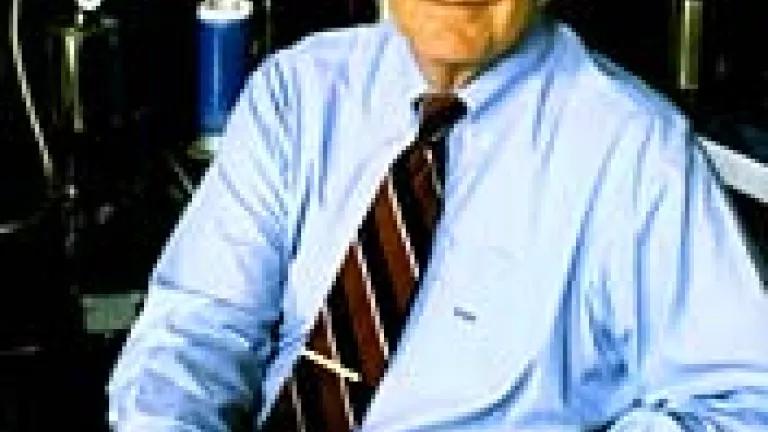
Courtesy of University of California, Irvine
Rowland and Molina discovered that the seemingly inert CFCs released from aerosol sprays, refrigerators and air conditioners, and many other products were rising high into the atmosphere and destroying the thin layer of stratospheric ozone that shields us from the sun’s dangerous ultraviolet radiation. For these insights they won the 1995 Nobel Prize in chemistry.
It is devilishly, almost poetically clever. Ozone is an unstable variant of oxygen – three oxygen atoms bound together instead of the more common two-atom molecule that we breathe. In the stratosphere, UV radiation is constantly making ozone molecules from oxygen, and constantly breaking those ozone molecules back down to oxygen. We’re safer down below because those ozone reactions absorb most of the UV and keep it from reaching the earth’s surface.
Rowland and his partner saw that the chlorine atoms in CFCs could upset the stable balance of ozone formation and destruction and erode the ozone shield. Very few chlorine compounds can reach the stratosphere, because they break up or are washed out far below. But nothing in the lower atmosphere harms CFCs. They break apart only when bathed in strong UV radiation. Then their chlorine atoms react catalytically to destroy ozone molecules, turning them back into oxygen faster than nature makes new ones, and throwing the ozone layer out of balance. Rising CFC production would mean steep ozone losses, more UV radiation reaching the earth’s surface, more skin cancer, and a host of dangerous health and environmental impacts.
Source: NASA
Some scientists would have stayed in the lab. But Rowland was also a citizen. He saw the danger, and he decided to speak out. It took courage, because there was a cost to speaking out. Rowland was harried by industries that produced and used CFCs, and shunned by scientific societies shy of controversy. The vindication of the Nobel Prize did not come for 21 years.
But when he spoke out, the public responded, and eventually governments did too. The story has been told very well in books like Between Earth and Sky, Ozone Crisis, and Protecting the Ozone Layer: The United Nations History. There’s also a new documentary called Shattered Sky, premiering March 22nd and 25th at the D.C. Environmental Film Festival (in which I have a bit part). Groups like mine, the Natural Resources Defense Council, took his lead, helped amplify his message, and catalyzed action by states, the federal government, and eventually the entire world.
And the ozone layer was saved. It took 13 years from Rowland’s discovery, but in 1987 some 40 countries agreed on the Montreal Protocol, a treaty to phase out CFCs and other ozone-destroying chemicals. Twenty-five years later, every country on earth is a party to the ozone treaty, and we have eliminated 97 percent of all ozone-destroying chemicals world-wide. There has been damage – most visibly the gaping ozone hole that appears over Antarctica each September, but we have largely avoided the catastrophe that Rowland warned of.
Rowland was chagrined that it would take so long. Early on he asked NRDC’s Dr. Karim Ahmed, who worked to protect the ozone layer long before me, how long it would take to remove CFCs from the marketplace. As Ahmed told me last week, he answered that it would be at least a ten-year struggle, Rowland “looked at me as if I had told him an unhappy bit of politically ‘realistic’ news,” Ahmed said.
But Rowland stuck with it, testifying before Congress and state legislatures, and doing hundreds of TV, radio, and print interviews. See him here, in a 1996 TV interview after having won the Nobel.
Fortunately, in the struggle to protect the ozone layer, we reached the tipping point for action before reaching the tipping point for disaster. In 2009 NASA scientists showed how awful it would have been had we not acted. In the words of NASA’s Dr. Paul Newman, “We simulated a world avoided, and it’s a world we should be glad we avoided.”
When it comes to climate change, we may not end up so well. The industrial and political forces defending our fossil-fueled status quo are even larger than those that stood against protecting the ozone layer. Just as the CFC lobby punished Sherry Rowland for speaking out, now the fossil-fuel lobby attacks climate scientists. A small cadre of “skeptic” scientists – many with direct financial ties to fossil-fuel or ultra-conservative funders – throws up dust in order to confuse the public. Some of these guys are the very same ones who made a career of harassing Rowland on ozone.
Consider the treatment of Penn State professor Michael Mann. His work – the so-called “hockey stick” graph – is one of several long-term temperature records demonstrating that global average temperature has climbed far above historical levels stretching back at least a thousand years. Mann has endured even more concerted attacks than those Rowland faced, including harassing lawsuits by Virginia Attorney-General Ken Cuccinelli that were finally thrown out earlier this month by the Old Dominion’s Supreme Court.
Sherry Rowland’s story is a model to all of today’s climate scientists facing this kind of intimidation. The greatest hoax is the attack machine trying to silence you.
Your work as scientists is essential. Your voice as citizens is magnificent.

